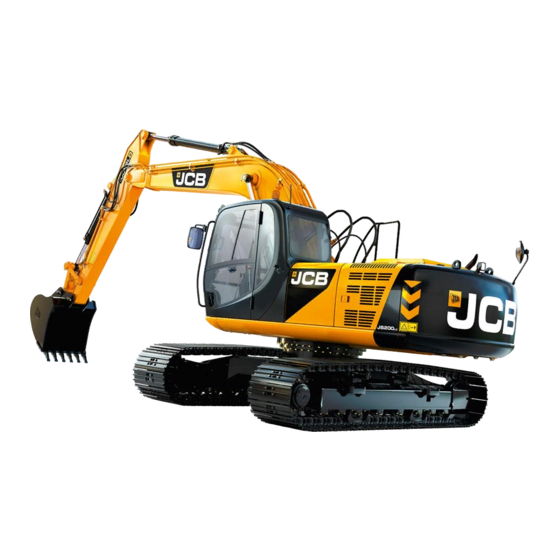
jcb JS200 Service Manual
Hide thumbs
Also See for JS200:
- Service manual (51 pages) ,
- Operator's manual (31 pages) ,
- Operator's manual (31 pages)
Table of Contents
Advertisement
Quick Links
Service
Manual
JS200
from machine no. 705001
JS210
from machine no. 705648
JS220
from machine no. 705001
JS240
from machine no. 708001
JS260
from machine no. 708501
PUBLISHED BY THE
TECHNICAL PUBLICATIONS DEPARTMENT
OF JCB SERVICE; ©
WATERLOO PARK, UTTOXETER,
STAFFORDSHIRE, ST14 5PA, ENGLAND
Tel. ROCESTER (01889) 590312
PRINTED IN ENGLAND
Publication No. 9803/6400
Issue 2
General Information
Care & Safety
R
Routine Maintenance
Attachments
Body & Framework
Electrics
Hydraulics
Transmission
Brakes
Track & Running Gear
Engine
1
2
3
A
B
C
E
F
G
J
K
Advertisement
Chapters
Table of Contents
Troubleshooting















Need help?
Do you have a question about the JS200 and is the answer not in the manual?
Questions and answers
Tracking movement backwards in both hare and tortoise mode works fine but tracking movement forward is very slow.
The forward tracking movement on the JCB JS200 may be slow due to several possible reasons:
1. Incorrect operating conditions – The machine must be operated with the track motors at the rear when traveling or excavating.
2. Lack of proper maintenance – Not following the maintenance schedule can affect track performance.
3. Improper shoe plates – Using the wrong type of shoe plates for the environment can cause inefficiency.
4. Excessive material packing – Material like soil or clay packed in the undercarriage can increase resistance and slow movement.
5. Harsh storage conditions – If stored in wet or freezing environments without proper procedures, components may not function optimally.
These factors can lead to increased resistance or wear in the undercarriage, slowing forward movement.
This answer is automatically generated
Trouble shoot no swing
To troubleshoot a no swing issue on a JCB JS200, follow these steps:
1. Check if engine starts and operates normally:
- If the engine does not start and “Electric system abnormality” is indicated, refer to Trouble No. 10.
- If the engine starts but rotation does not change with throttle, controlling engine rotation may not be possible.
2. Check hydraulic system components:
- Inspect for sufficient hydraulic oil amount; refill if low.
- Check the hydraulic oil strainer for contamination; clean or drain as needed.
- Ensure oil levels in reduction gears are adequate; refill if needed.
3. Check for mechanical or control blockages:
- Inspect the remote control valve for:
- Low secondary pressure due to low primary pressure—apply correct primary pressure.
- Damaged spring—replace the spring.
- Excessive clearance between spools and casing—replace the remote control valve.
4. Inspect motor operation:
- If motor does not run or rotates slowly:
- Check for pressurized oil; inspect pilot piping for damage.
- Remove foreign matter between plunger and body, orifice, or dumper piston and cap.
- Repair or replace damaged parts as needed.
5. Check electrical and wiring connections:
- Inspect battery terminals and alternator wiring for looseness or corrosion; tighten or replace as needed.
These checks cover both hydraulic and electrical causes that could lead to a no swing condition.
This answer is automatically generated